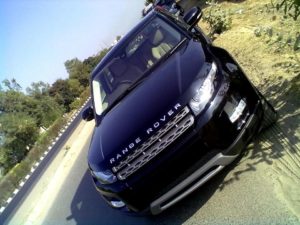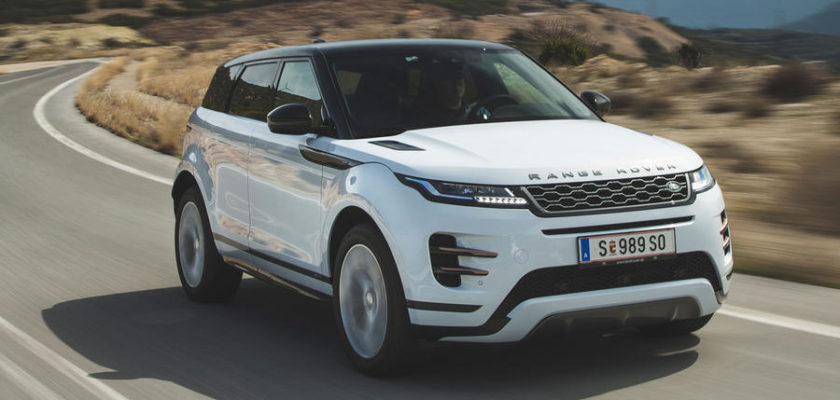It says Range Rover on the tin, therefore taking it off-piste shouldn’t be a problem. This, nevertheless, isn’t likely to be easy, no sir. The route to the river is deeply rutted, the gradient is steep, and then, what makes things more interesting is the rounded riverbed rocks act like ball bearings beneath the wheels. Forget driving, walking here is fraught with trouble.
First things first; should get the installation right. There’s no conventional Terrain Response dialup, which foxes me for a bit. Then with a spotter on the exterior to check for ground clearance, I crawl forward. This edition of this Evoque I am driving does not have air springs or a lift’ attribute, so I want to be careful to not ground it. This is good since, despite all the rubble and loose stuff, it appears to have a vice-like grip on the ground below. And what makes driving the Evoque simpler is the throttle responses are metered. This is doubly true on the arduous climb back up, where grip and the smooth launch of torque from the engine at low engine speeds are much more important. A little more ground clearance and the baby Rangie may be mega to the rough stuff, transverse-engine, front-biased four-wheel-drive setup and all.

Range Rover Evoque
Anyhow, DNA test performed, it’s time to contact the street. Used by overloaded trucks, ironically providing a road-building project near, the surface is completely bombed out. A group of poorly filled-in potholes and heat-warped ripples, with little patches of regular tarmac, sprinkled loosely in between — it’s just a nightmare. I start slow, and this induces a small number of vertical movement. The Evoque’s fairly stiff installment frees us around over some of those sharp-edged bumps and there’s a little bit of firmness detectable even over some of the patchy tarmac. However, as I go a bit faster, the journey improves considerably. The tall springs now seem to work better, the dampers rounded off lumps well, and then what impresses is that the quicker I journey over this patchwork highway, the more comfortable the Evoque feels.
For a little while it seems this patchwork road will continue forever, but then all of a sudden, we encounter a component that’s been freshly surfaced. It is not billiard-table smooth and carries tell-tale signs of a done job, with lots of tiny drops and sudden changes in the surface. Now, generally, corners like these wouldn’t elicit this much excitement sat behind the wheel of an SUV, but there is something about its demeanor that informs me Range Rover’s baby will enjoy the challenge. Yes, the new Evoque includes a roughly 20mm longer wheelbase, and that could nix some of the earlier car’s beams, but the newest platform on which it’s built also has a new floorplan that improves body rigidity by around 17 percent.
Also, what I love is the way neatly and fast it tucks in if you end up running a bit broad. Must say this thing is very fun. I especially love the relaxed assurance it radiates, and the steering is beautifully weighted and feels exactly right because of its application here.
The Evoque is super-stable at elevated rates. Long stretches of highway have me just gripping the steering lightly, and all I want to do to direct it into more and faster corners is just hint it in. Adding hugely to assurance levels will be the wheels. Not only a footnote here however a bedrock of stability, but the wheels also bleed speed effortlessly and pedal feel is strong, no matter how hard you brake.
JLR’s 180hp Ingenium petrol is also impressively smooth at idle. The cabin is well insulated from the low-speed rumble and the typical diesel clatter, and also what feels good is that the motor responds well the moment you tap the throttle. In fact, with its variable geometry turbo and quicker responding 9-speed automatic, the newest Evoque is fairly quick on the draw at a low rate. What also helps is that the engine makes a very useful 430Nm of torque from as low as 1,750rpm. So cross 2,000rpm and there is a nice hit of torque, in addition to a big shot of increase from the turbo. Even nicer is the fact that the engine continues to pull ardently past 3,000rpm, and this causes this BS6 diesel engine feels particularly effortless.
Flat-out performance, however, is not all that exciting. The engine feels somewhat flat once you cross 4,000rpm and there is not any big increase in performance even if you spin it faster. What makes the procedure feel much more useless is the engine gets quite vocal and drones quite a little.
Also, ask for a quick burst of acceleration as well as the 9-speed gearbox does not exactly comply. Yes, pruning is improved compared to the earlier version, but there still is a bit of a delay between putting your foot on the accelerator and a decrease gear being chosen. And there’s even a lot of jerkiness as you go off and on the throttle. Overall, however, and for the most part, the Evoque inside this 180d shredder is smooth, responsive, secure and prepared, and that feels fantastic.
Fashion icon
The Evoque, of course, is an extremely pleasing SUV to look at. Less hardy Land Rover and more
La-di-da fashion icon, the newest Evoque gets people’s attention wherever it goes. And the simple fact that many confuse this new one with the magnificent Velar does its prospects no damage in any way. Truth be told, it is difficult to tell the two apart as they share several attributes. Both get laid-back mesh grilles, slim-line headlights with rectangular LED inserts, headlight extensions that run onto the front doors, severely tapering rooflines and steeply rising beltlines. They look similar from the rear with the stunning, layered LED tail-lights. So, size aside, how do you tell you from the other, particularly if all you get is a glance? Not that easy. .so listen 007.
The new Evoque uniquely gets an extra slot-like opening under front grille, the bonnet line runs around the big front wheel arch, and across the side, there’s a steeply sloping cut or shoulder line. And in the back? Your very best option is to search for the badge. Much like all futuristic and modern designs, wheel size is important, and here the’S’ gets 18-inch metals which strike a fantastic balance.
It seems lavish on the inside; high-quality materials abound.
The design on the inside is equally stunning. Minimalistic in extreme, the focus of the cottage stays the soft dashboard with lower and upper halves characterized using a station between. I particularly enjoy the hooded cobra-like tool panel cowl, how the vents have been cupped in between the two layers of the dash is super, then there’s the awesome chrome surround that runs around the touchscreen. And I also enjoy how the feather-touch steering wheel controllers can be reconfigured according to the menu you’re in. While the version on evaluation, the’S’, has regular dials and only one touchscreen, the higher-spec SE version gets an extra touchscreen.
Slick operation and a high level of performance also seem to be extremely important here. Both control wheels placed before the now-traditional gear lever (no rotary dial this time around) function beautifully. The dials can be used for many manners, which you may select. But, I don’t like the fact that you need to swap modes to control fan speed; it is a pain when you’re driving and wish to keep your eyes on the road. However, I must say I do like the soft tray above the cupholders on your telephone, and that the person’s elbow rests breaks down the center, and then chair comfort on the front chairs is seriously excellent.
Panoramic sunroof brightens cottage and does not consume into the headroom.
This isn’t exactly the ideal car to be chauffeured around in, nevertheless, comfort levels in the back are not too bad. It’s true, you’re seated a bit low due to the diving roofline, and the legroom is only decent. The seat though is fairly large and comfortable, the backrest is reclined, and the headroom, despite the panoramic sunroof, is not too bad for those under 6ft. What helps here is that the sunroof is designed in such a way that it doesn’t impinge on the headroom.
You’re sat low but the chair is well put together; legroom is sufficient too.
Seating three abreast at the trunk, however, isn’t a fantastic idea. The cabin is a bit narrow and visibility out the rear isn’t very good either on account of these fat C-pillars. So, while space may be at a high in the Evoque, it certainly is comfortable enough and feature-rich, particularly if you opt for the SE version (see box), where for approximately Rs 5 lakh additional, you get a good amount of kit.
Size is not everything
The Evoque is not for everyone — and not for those who think size and cost are directly proportional. Here compactness is a virtue, attitude, posture and fashion matter over practicality, and that which separates this luxury SUV from its rivals is that owners often drive themselves.
That the Evoque manages to deliver in most regions there is no doubt. Yes, the ride might have been a bit more comfortable at reduced speed, a bit more energy and performance could have been fine, and it’s not nearly as well equipped as it should have been, considering its expected starting price of around Rs 50 lakh. Do remember, however, the better-equipped SE version can be obtained for not all that much more, and for those interested in greater power and performance, there also is going to be a 249hp gas — that the P250.
Closer in cost to rivals a complete size up, such as the BMW X3 and the Audi Q5, the new Evoque clearly is not a car you purchase with your mind; but the Evoque has always been an emotional option.
